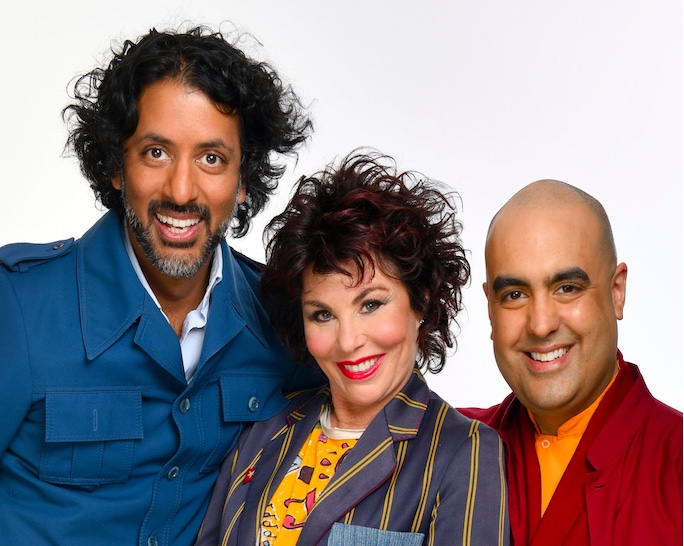We love this article from our Summer 2019 issue, in which we learned all about the new book ‘How to Be Human’: a collaboration between comedienne and mental health pioneer Ruby Wax, Buddhist monk Gelong Thubten and neuroscientist Dr. Ash Ranpura.
Mind Doctor
Ruby Wax and friends on happiness
by Aisling Cronin
Ruby Wax has been well-known as an actress, comedienne and television personality for decades, but in recent years, she began to develop an interest in mindfulness and mental health. Her own experience of depression led her to undertake deep research into these important topics, with the hope of helping others who were suffering too. In 2013, she earned a master’s degree in mindfulness-based cognitive therapy from Kellogg College, Oxford. This was followed in 2015 by her appointment to the position of Visiting Professor in Mental Health Nursing at the University of Surrey.
Ruby’s dedication to helping people improve their outlook on life has continued to grow ever since.
Ruby’s expertise on the topic of mental health was made clear in her 2018 book, How to Be Human. She combined her own experience and insights with those of Buddhist monk and meditation teacher Gelong Thubten, and neuroscientist Dr. Ash Ranpura. The book soon attracted glowing tributes from a wide range of luminaries. Author Neil Gaiman described the book as ‘one of the most fascinating, intriguing and informative books about minds and bodies and brains and mindfulness I’ve ever encountered’, while actress Joanna Lumley said, ‘How to Be Human is, without exaggeration, a lifeline; wise, practical and funny.’
Ruby’s passion for her subject matter is evident in every page. She wrote: ‘It took us 4 billion years to evolve to where we are now. No question: anyone reading this has won the evolutionary Hunger Games by the fact you’re on all twos and not some fossil. This should make us all the happiest species alive, yet most of us aren’t. What’s gone wrong? We’ve started treating ourselves more like machines and less like humans. But even if nearly every part of us becomes robotic, we’ll still, fingers crossed, have our minds, which, hopefully, we’ll be able to use for things like compassion rather than chasing what’s ‘better’, and if we can do that, we’re on the yellow brick road to happiness.’
Her co-authors’ insights also have much to teach us about how the mind works. Neuroscientist Dr. Ash Ranpura offers some fascinating scientific explanations as to what makes us ‘us’ in the brain. Gelong Thubten – who has been a practising Buddhist monk since 1993 – draws on his vast experience to talk about the nature of the mind. He also provides some mindfulness exercises that can be very easily practised in our day-to-day lives.
Gelong’s understanding of mindfulness has to do with learning how to let go. ‘It’s not about self-obsession: going within and obsessing over every single thought we have,’ he says. ‘It’s about being the silent observer that doesn’t get attached to all that. Let it all go by you, like clouds in the sky.’
Ruby’s comedy experience has contributed to her understanding of what makes the mind tick. In a conversation we had with her recently, she said, ‘when I’m talking about the subject of mental health, I have an instinct for when to be serious and when to lighten people up with a joke. When I start a talk, I find that there is a natural rhythm to it: a time to laugh and a time to be serious.’
Ruby’s sense of humour is evident throughout How to be Human. ‘There’s a sense of balance we sought to achieve in the book: I bring the comedy, the monk explains how the mind works, and the neuroscientist says, ‘this is where it all is.’ I think when you put it all together, you get a complete picture of who we are. You see that life isn’t so frightening. We’re all human. We all have the same experiences.’
The advancement of technology – and the impact this has had on our minds – is something the authors wanted to explore in greater depth in How to be Human.
Dr. Ranpura said, ‘One of the things we talked about in the book is how people go to the gym, but tend to wear headphones, or even watch television, while doing their workout. Even as they’re toning the body, they’re actively practising disassociation – they’re actively disconnecting from their bodies. This can become a habit for people, so that every time they use their bodies, they automatically disassociate from it.’
‘The book explains how addiction manifests itself in the brain,’ Ruby told us, ‘and there are techniques you can use to lower your cortisol and reduce your dependency on technology. We all use technology all the time, and it has become an addiction for a lot of people. You can learn how to step away from the computer: use it when you need to and put it away when you don’t. That takes discipline, but it is possible!’
Ruby’s warmth, practicality and wit makes How to be Human a joy to read. Hilarious anecdotes from Ruby’s own life are backed up by smart science and practical mindfulness exercises, making How to be Human ‘the only manual you need to help you upgrade your mind as much as you’ve upgraded your iPhone.’


